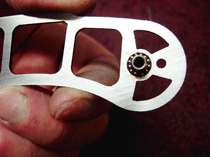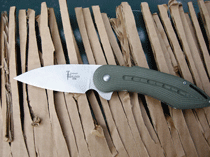Now, before you think you have gone to an aviation website by mistake, I am not talking about the famous Russian jet fighters built by Mikoyan-I-Gurevich, but about Todd Begg’s New MIG (Military Issue Glimpse), a tough, hand-held fighter. Begg is one of the three well-known knifemakers whom I just happen to live near. In fact, he is only 2.3 miles from my door. There, in his well-appointed shop, he turns out custom knives and, more recently, his military version of his Glimpse model. With his wife Tanya, who handles his sales and paperwork, and Kyle Hutchinson, a college student who fills in as his shop assistant, Begg is producing a tough, tactical folder that has found instant acceptance with the military personnel to whom it has been issued.
 Yes, I said “issued.” Close by Begg’s home is the U.S. Army’s sprawling Fort Lewis; next-door is the U.S. Air Force’s McChord AFB, and right across Interstate 5 is the Camp Murray Reserve Center. What all of these Army and Air Force units have in common is that they are deeply involved in the Global War On Terror (GWOT), often in non-traditional roles. Army artillery units are serving as dismounted Infantry, and Air Force units are running ground convoys for Army units. Several of these units (I am not at liberty to mention specific groups) had found out about Begg’s work and approached him about making a military version of his Glimpse. Named the MIG, these folders are purchased by the units and then issued to individuals in those units.
Yes, I said “issued.” Close by Begg’s home is the U.S. Army’s sprawling Fort Lewis; next-door is the U.S. Air Force’s McChord AFB, and right across Interstate 5 is the Camp Murray Reserve Center. What all of these Army and Air Force units have in common is that they are deeply involved in the Global War On Terror (GWOT), often in non-traditional roles. Army artillery units are serving as dismounted Infantry, and Air Force units are running ground convoys for Army units. Several of these units (I am not at liberty to mention specific groups) had found out about Begg’s work and approached him about making a military version of his Glimpse. Named the MIG, these folders are purchased by the units and then issued to individuals in those units.
Glimpse Of The Glimpse
The MIG is a substantial knife, measuring in with a blade that is 3-3/4 inches long, 5/32 inch thick, and 1-1/4 inches at it widest point. The blade has a unique shape, sort of like a Wharncliffe blade, except the edge is not straight; rather, it gently sweeps upward toward the point. It has a dull finish and a high, flat grind that cuts extremely well. There is a finger cutout/choil and a “flipper” that also works as a finger guard. The frame of the handle is made from 410 stainless steel, with G-10 slabs. The MIG comes with what looks to me to be foliage green slabs, which are fluted in an elongated circular pattern. Begg’s signature center groove, with alternating deep and shallow holes, is right down the center of the handle, and there is a 7/8-inch long slot on the butt for a lanyard. The handle is 5-1/8 inches long; the MIG opened is 8-7/8 inches long and it weighs in at 6.25 ounces.
Advertisement — Continue Reading Below
Five-Star Blade Steel
Begg uses 154 CM stainless steel for the blade, with an HRC of 59. He has his heat treat done by Pacific Metallurgy, which is an aerospace company here in Washington. Begg has high praise for not only the quality of their work, but also for the consistency of their work.
 When you first open a MIG, you will be impressed with just how smoothly it does open and the reason for that is the IKBS system. IKBS translates to the “Ikoma Korth Bearing System,” which was invented by a Brazilian knifemaker. It consists of 12, 1/16 of an inch, Grade 25, 52100 Timken ball bearings per side for a total of 24 ball bearings that the blade pivots on. Each ball bearing is Rockwell tested. My first thought was how do you Rockwell test a 1/16 of an inch ball bearing? It is not done the conventional way with a diamond-pointed probe that is pressed into the ball bearing. Rather, someone figured out that if you drop a ball bearing from a specific height onto a horizontal steel plate of a certain HRC, the height the ball bearing bounces would tell its HRC. I wondered how hard it would be to put the ball bearings into their circular channel in the frame. Not hard at all it turns out; Begg simply puts a little grease on his finger, runs it into the container of ball bearings and just wipes the bearings off into the channel. The pivot pin for the blade is made from 416 stainless steel.
When you first open a MIG, you will be impressed with just how smoothly it does open and the reason for that is the IKBS system. IKBS translates to the “Ikoma Korth Bearing System,” which was invented by a Brazilian knifemaker. It consists of 12, 1/16 of an inch, Grade 25, 52100 Timken ball bearings per side for a total of 24 ball bearings that the blade pivots on. Each ball bearing is Rockwell tested. My first thought was how do you Rockwell test a 1/16 of an inch ball bearing? It is not done the conventional way with a diamond-pointed probe that is pressed into the ball bearing. Rather, someone figured out that if you drop a ball bearing from a specific height onto a horizontal steel plate of a certain HRC, the height the ball bearing bounces would tell its HRC. I wondered how hard it would be to put the ball bearings into their circular channel in the frame. Not hard at all it turns out; Begg simply puts a little grease on his finger, runs it into the container of ball bearings and just wipes the bearings off into the channel. The pivot pin for the blade is made from 416 stainless steel.
MIG Test Flight
I had to ship a 36-inch-tall, carved wooden eagle back to the East coast. Luckily, I had several large cardboard boxes that, once modified, the carving would fit into. Using the MIG to do this, I was quite impressed with the way it cut cleanly through the thick cardboard. Given how easily the blade just seemed to glide through the cardboard, it was almost like opening an envelope. I also had to cut down a second cardboard box to line and make the first box double walled. After about an hour of cutting up cardboard and bubble wrap, I was done. Even after this workout, the MIG was still razor sharp.
Advertisement — Continue Reading Below
 I like the size of the handle, as it gave a very secure grip, and the blade is long enough for most everyday chores. I did note initially that the titanium pocket clip was digging into the palm of my hand, which is fairly common with spring carry knives. Then I moved my forefinger forward and into the cutout /choil and placed my thumb on the spine of the blade. Now I could apply all the force I needed to and the pocket clip no longer bothered me. I was able to cut flat surfaces onto a tree branch that were so smooth it looked like it was done with a plane. Edge retention was very good, and when needed, a few swipes per side on my diamond hone and it was back to shaving sharp.
I like the size of the handle, as it gave a very secure grip, and the blade is long enough for most everyday chores. I did note initially that the titanium pocket clip was digging into the palm of my hand, which is fairly common with spring carry knives. Then I moved my forefinger forward and into the cutout /choil and placed my thumb on the spine of the blade. Now I could apply all the force I needed to and the pocket clip no longer bothered me. I was able to cut flat surfaces onto a tree branch that were so smooth it looked like it was done with a plane. Edge retention was very good, and when needed, a few swipes per side on my diamond hone and it was back to shaving sharp.
Opening/IKBS
Admittedly I had little experience with a flipper opening system but, after Begg demonstrated it to me, I quickly picked up the technique. Just enough of the blade sticks up out of the handle that I was also able to pinch the blade and then rotate it completely open with my thumb. As a test, I handed the MIG to my daughter (not a knife person) and asked her how to work the flipper. She opened it with no problem. I closed the MIG and handed it back to her and said, “Do it again.” She flipped it open, looked at the frame lock, closed the blade and handed the MIG back to me saying, “It is easy to do,” and went back to her computer. Incidentally, the frame lock was equally easy to disengage, and yet provided a positive lockup each and every time. Hitting the back of the blade on my desktop did not disengage the bar, nor did it disengage during any of my testing.
Carry Considerations
Although the MIG is a substantial-sized folder, I found it rode in my right trouser pocket without problem. With my BDU-styled trousers, I carried it in the top of my cargo pocket, making it easily accessible even when wearing full battle-rattle. My hand naturally falls right at the top of my cargo pocket. When sitting down, it was much easier to access the MIG in this position than in a side trouser pocket. Thinking about all the time spent patrolling in vehicles during this current war, it made sense to me to use the cargo pocket. The other spot would be somewhere in the center of an assault vest, where it would be accessible to either hand. While I didn’t try cutting a seatbelt, with the rounded spine of the MIG, you could carefully stick the spine against someone’s chest and, using the spine as a guide, run the blade of the MIG under the seatbelt. What with the use of IED’s in theater, this is a nice capability to have.
Advertisement — Continue Reading Below
Downside?
The only downside I see to the MIG is that it was not around to be issued to me during my war! Seriously, the MIG is a highly capable, tough and functional folder that the personnel who are using it have immediately recognized as a quality item, one that they are fortunate to have by their sides.
While you cannot get one of the issue-model MIGs, you can buy a civilian version($450); so if you are interested in a highly capable, tough folder, then give Begg knives a call.























